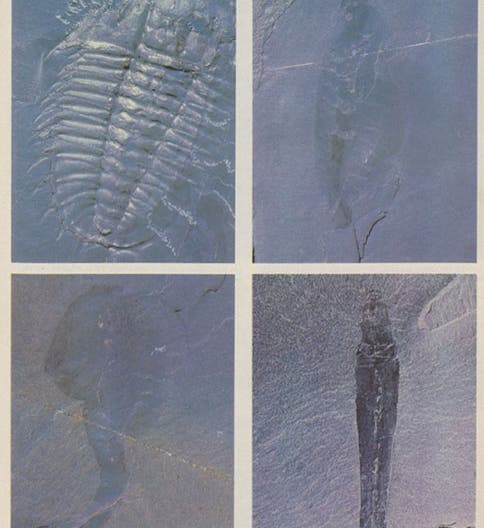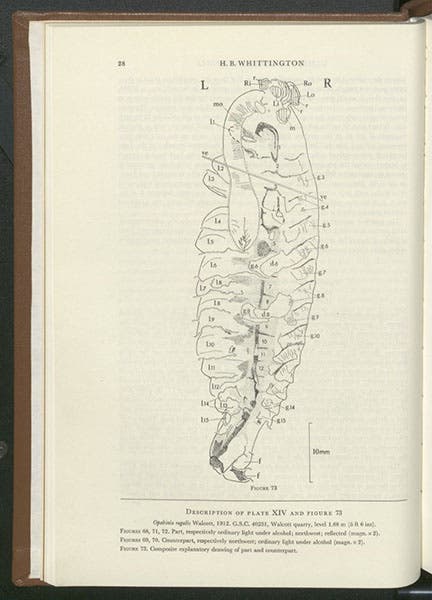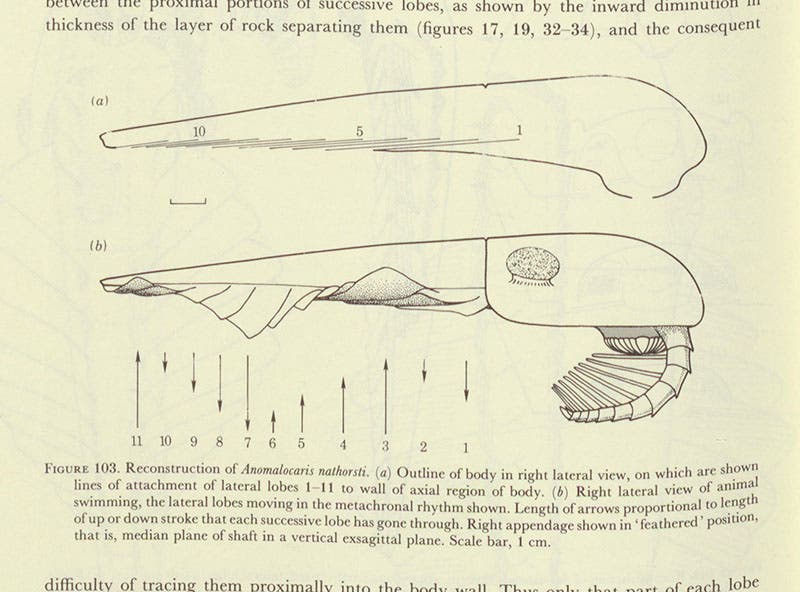Scientist of the Day - Harry Whittington
Harry B. Whittington, an English paleontologist, was born Mar. 24, 1916, near Birmingham. He studied science at the University of Birmingham, and received his PhD there as well. HIs first postdoc had him studying Paleozoic fossils in Wales, which introduced him to trilobites, and they were to become his central interest for the next thirty years. After World War II, in 1949, he was hired by the Museum of Comparative Zoology at Harvard, where he continued his pursuit of trilobite expertise, becoming the foremost authority in the world on those familiar tri-lobed arthropods.
In 1966, his interests shifted. In that year, the Geological Survey of Canada offered him the position of team leader for an expedition with the mission of re-opening the Burgess Shale quarry in British Columbia. This was a site rich in mid-Cambrian fossils (thought to be 530 million years old in Whittington’s day, now redated to 508 million), and unusual because it preserved many soft-bodied organisms that ordinarily escape fossilization. The quarry had been opened by Charles Doolittle Walcott in 1909, who extracted, studied, and photographed tens of thousands of fossils, many of them trilobites, but most of them totally unknown organisms that were difficult to classify. Walcott's specimens went into the Smithsonian Institution (of which Walcott was Secretary), and they had been sitting there, little studied, for the 40 years since Walcott died. Canadian museums had few Burgess Shale fossils, and they wanted some of their own. Indeed, they wanted a lot of them. And so the Geological Survey sent out their own expedition in 1966. Whittington accepted the position because he wanted new trilobite fossils.
Very quickly, however, other organisms attracted his attention. Walcott had tried to shoehorn his specimens into known taxa. It became clear to Whittington that there were many new species, and probably a few new phyla, represented in the Burgess Shale. And he began to try to sort them out. It required new techniques, because the soft parts were preserved in the slate as films, which were not easy to interpret. The first organism he tackled was Marella, the most common animal in the Burgess Shasle, and considered a trilobite by Walcott. Whittington wasn’t so sure, and by the time he published his first paper on a Burgess Shale organism in 1971, on Marella, he was sure it wasn’t a trilobite. And when he tackled Opabinia, he knew he had an organism that existing phyla could not accommodate. Opabinia was a creature with 5 eyes, the central one fixed, and the other 4 on stalks; it had what looked like a trunk sticking out in front, with tiny barbs or claws on the end; and a gut that ran from back to front and did an abrupt 180° turn when it got to the head, so that the mouth of the gut faced backwards. Apparently Opabinia gathered food with its proboscis, which was long enough to reach back and tuck the morsels into the backward-facing mouth. Whittington recounted that he gave a professional presentation describing Opabinia, and the audience actually laughed out loud when he showed a slide of the reconstruction, the creature was so absurd and unlikely. But he published his paper in the Philosophical Transactions of the Royal Society in 1975, and it became a landmark in Cambrian studies. We show here several images from that paper; 5 photos of the fossil films (third image); a drawing by Whittington of one of those fossils (fourth image), and a reconstruction of the living animal (fifth image), the drawing that evoked all that laughter.
The last organism we will mention by name is Anomalocaris, first fully described by Whittington and his student Derek Briggs in 1985. Anomalocaris was huge, by Cambrian standards, over one foot long, with a circular bony mouth with teeth on the inside of the ring. Apparently, the animal easily fell apart after death, for Whittington discovered that three of Walcott’s Burgess Shale species were actually separate parts of Anomalocaris; the boney mouth, for example, found by itself, was thought to be some kind of free-swimming coelenterate, named Peytoia by Walcott. Whittington and Briggs rebuilt the organism properly and showed their reconstruction in another paper published in the Philosophical Transactions in 1985 (sixth image, below). The mouth of Anomalocaris, formerly, Peytoia, is shown in side view on the bottom of the head at right.
Whittington and the Burgess Shale fossils became known outside the small circle of Cambrian paleontologists when Stephen Jay Gould published a book on the fossils in 1989. (Gould had been hired by Harvard to fill Whittington’s position when Whittington left for the University of Cambridge in 1967). Gould’s book was called Wonderful Life, and it was, surprisingly, a best-seller. Gould, who was one of the cofounders of the idea of punctuated equilibrium, had an agenda of his own, wanting to show that the phyla that survived the Cambrian explosion were just the random, lucky few, and that had the Cambrian period been repeated, the survivors would probably have been entirely different, perhaps descended from some of the mysterious phyla of the Burgess Shale (and with humans very likely missing from the re-enactment). Most other paleontologists seem to think that the Burgess Shale organisms, strange though they may be, do fit into the general pattern of Cambrian evolution, even if many of the phyla did not survive.

Recreation of the Burgess Shale site, 530 million years ago, a detail of a larger image, restoring to life, among others, Marrela (15); Opabinia (19), Wiwaxia (24), Hallucigenia (18), and Peytoia (10). Whittington will later show that Peytoia is the boney mouthpiece of Anomalocaris, the largest of the Burgess Shale animals; drawing by Tom Prentiss for article, “The animals of the Burgess Shale,” Scientific American, July 1979 issue (Linda Hall Library)
The best introduction to the Burgess Shale of Whittington’s day is a Scientific American article, “The animals of the Burgess Shale,” written by Whittington and another student, Simon Conway Morris, and published in 1979. It has a text that you and I can understand; good photos of many of the shale fossils in situ, including four in color (first image); and offers a reconstructed scene of what the various Burgess Shale organisms might have looked like in action. We show here a detail from that reconstruction (seventh image), where you can see three little Marrela scuttling about (15), an Opabinia (19), and some weird beasties we didn’t discuss here, Wiwaxia (24), and the wonderfully named Hallucigenia (18). Since this was before Anomalocaris was reconfigured, the complete organism is not shown, but its mouth ring, looking like a pineapple slice, is depicted as a separate organism, Peytoia (10).
We conclude by offering you a short 15-second animation, courtesy of the Royal Ontario Museum, of the Burgess Shale giant, Anomalocaris, swimming across the ocean floor before the silt came tumbling down. It is as good a legacy for Whittington as anything I have found. You can see several more animations of Burgess Shale animals, and some models, at the Museum’s Burgess Shale webpage.
Dr. William B. Ashworth, Jr., Consultant for the History of Science, Linda Hall Library and Associate Professor emeritus, Department of History, University of Missouri-Kansas City. Comments or corrections are welcome; please direct to ashworthw@umkc.edu.











